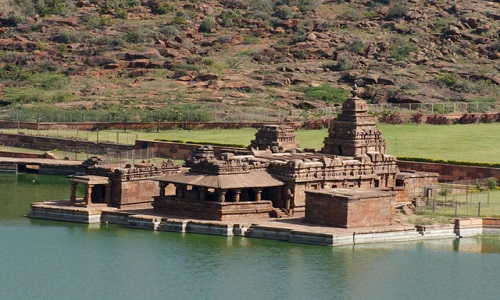The Differences between North and South Indian Hindu Temples
The structure, art-work, and location of traditional Hindu temples in India, known as mandirs, are based on ancient Indian texts known as Shilpa Shastras (The Science of Arts and Crafts) and Vastu Sastras (The Science of Architecture). The recommended sites for mandirs include gardens and places of natural beauty like forests, hill-tops and mountain slopes where flowers bloom and birds and animals abound in their natural habitat; seashores, and the banks of rivers and lakes; places near the confluence of rivers; inside caves; and at the head of town streets. Visitors enter the temple precincts through a porch supported by carved pillars and walk up a flight of steps to reach the temple proper, whose heart is the garba griha (womb-chamber) that houses the idol of the main deity. Since Hindu worship is not generally congregational, but is mainly personal (except for special occasions), the garba griha is a small room where often only the priest is permitted access. It is symbolically united with the heavens by means of a tapered tower rising above it, and is surrounded by a passage to permit circumambulation. Usually below the deity, and sometimes above it, is an undecorated hollow space that symbolizes Purusa, the all-pervasive, formless, indestructible, and eternal Universal Principle.
Apart from representing divinities, the carvings and statues in Hindu temples also reflect what are considered the four goals of human life – artha, or wealth and prosperity; kama, or pleasure and sex; dharma, or religious and moral duty; and moksha, or release from the cycle of rebirth.
The Architectural Classification of Indian Hindu Temples
The Vastu Sastras classify three types of temple construction – in the Nagara or Indo-Aryan or Northern Style; in the Dravida or Southern Style; or in the Vesara or Mixed Style. The distinctive styles are believed to be the product of climatic, geographical, racial, ethnic, and linguistic variations.
One of the most obvious differences between the temples in the north and those in the south lies in their sizes. The temples of Northern India are nowhere near the size of their southern counterparts. The Srirangam Ranganathar temple in the state of Tamil Nadu, for instance, occupies all of 156 acres, which is larger than the entire area of Vatican City. Water tanks and shrines within the temple complex are other distinguishing features of South Indian temples. However, it can be generally said that many of the famous North Indian temples enjoy the advantage of being located amidst breathtaking scenery, as for instance the temples in Kedarnath and Badrinath, which have the majestic Himalayas as their backdrop, or the temples in Rishikesh, through which the lordly Ganga flows in all its grandeur.
Next comes the shape of the towers. The northern variety is called a shikhara, literally ‘mountain peak’, and gradually inclines inwards in a gently curving profile. It is built over the garba griha, and is the temple’s most prominent feature. On the other hand, the tower in a southern-style temple is pyramidal in structure, and has many storeys or pavilions which get smaller and smaller the higher they go.
The gateways of the temples also mark a sharp difference between the two styles of architecture. While Northern Indian temples lead from a gate of lower height to a much taller tower above the garba griha, in the southern variety, the biggest towers, the gopurums, enormous gate-pyramids, adorn the entrance, dominate the temple site, and lead to the smaller tower of the temple itself.
Examples of North and South Indian Hindu Temples
Some of the best examples of the northern style of Hindu temple architecture are found in the Konark Sun Temple in the state of Odisha, and the temples in the Khajuraho Group of Monuments in the state of Madhya Pradesh, which are all UNESCO world heritage sites, as are some of the pre-eminent representatives of the southern style of Indian Hindu temple architecture, such as the Brihadeeswarar Temple in the state of Tamil Nadu, and the cave temples, the Shore Temple, and the Olakkanesvara Temple in the Group of Monuments at Mahibalipuram, also in the same state.
Unlike in the case of most other religions, it is not considered obligatory for Hindus to visit a temple. More likely than not, they will have a room – called the ‘puja room’ – set aside in their homes for daily prayer and worship, and it is only during religious festivals and other auspicious occasions that Hindus flock to temples in great numbers.
- Differences between Hold and Keep - November 9, 2015
- The Difference Between Did and Have - November 9, 2015
- Differences between Enquiry and Investigation - October 25, 2015
Search DifferenceBetween.net :
 Email This Post
: If you like this article or our site. Please spread the word. Share it with your friends/family.
Email This Post
: If you like this article or our site. Please spread the word. Share it with your friends/family.
2 Comments
Leave a Response
References :
[0]www.pilgrimage-india.com
[1]www.essential-humanities.net
[2]www.preservearticles.com
[3]eu.wikipedia.org/wiki/Hindu_temple_architecture
[4]https://en.wikipedia.org/wiki/Hindu_temple



Great post!! you have articulated very well between north and south Indian temples. Thanking you again.
Thank you